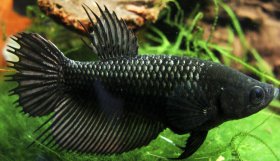
 Betta fish (Betta splendens) are one of the most popular fish species available today and male Bettas are widely appreciated for their wide range of beautiful colors and many fin types. Female Bettas, however, are a lot more difficult to find in the hobby and overlooked by most aquarists. They are often thought of as ‘dull’ compared to their male counterparts – even though their colors can be just as lovely and there are actually a few advantages to keeping females.
Betta fish (Betta splendens) are one of the most popular fish species available today and male Bettas are widely appreciated for their wide range of beautiful colors and many fin types. Female Bettas, however, are a lot more difficult to find in the hobby and overlooked by most aquarists. They are often thought of as ‘dull’ compared to their male counterparts – even though their colors can be just as lovely and there are actually a few advantages to keeping females.
Keep reading for everything you need to know about identifying female Bettas and why you might want to consider them over males!
Note: There is a lot of inaccurate info on Betta keeping out there. Bettas should always be kept in an aquarium of at least five gallons. If you’re interested in keeping Bettas, be sure to have a look at the full Betta caresheet.
Figuring out whether a Betta is male or female can sometimes be a little difficult, especially because they’re often unlabeled or mislabeled in pet- and aquarium stores. Female Bettas are short-finned so if a Betta has very long finnage it’s almost certainly male (with some exceptions), but what about short-finned (plakat) males? Here’s what you should be looking at if a short-finned Betta is causing some confusion:
- Ventral fins: The ventral fins are located on the underside of the fish just below the head. Male Bettas will often sport long ventral fins. In females, just like the rest of their finnage, the ventrals will usually be a lot shorter.
- Anal fin: Female Bettas will often have a rounded anal fin, while most males have a pointed anal fin.
- Body shape: A female carrying eggs is quite easy to recognize: her belly will look round and swollen. Even when not eggy, females will still be slightly rounder (and smaller) than males.
- Ovipositor: Also called an egg spot, female Bettas have an ovipositor which looks like a tiny white speck or grain of salt right behind their ventral fins. Just don’t confuse a protruding vent with an ovipositor – always double check using the other items on this list, as males can sometimes appear to have an ovipositor even though they don’t.
- Beard: Both male and female Bettas have a beard, which becomes visible when they flare their gills. However, the beard will be much larger in males than in females.
- Bubble nesting, aggression, color: While these can differ, they won’t always. Most female Bettas don’t build bubble nests, but some will. Most female Bettas will be less aggressive than males, but some definitely aren’t. Some female Bettas will have less bright coloration than males but many will be just as colorful!
Keep in mind that female Bettas can be very similar to males: don’t just rely on one item on this list, be sure to check all of them. Sexing young Bettas can be especially difficult, so you might want to double-check once the fish has matured.
This slideshow requires JavaScript.
For hobbyist fishkeepers, keeping female bettas is often not the first thing that comes to mind. Males are thought of as more attractive with their often extravagant finnage, whereas females are seen as boring or bland. In reality they are just as active and fun to watch as their male counterparts. They will still flare, explore their aquarium and eventually recognize their owner.









